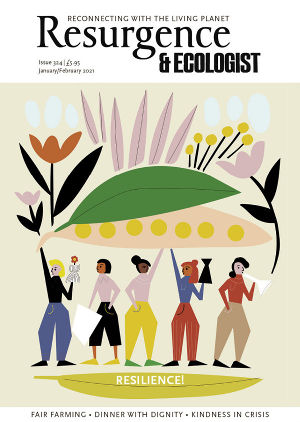In his 1975 book Unfinished Animal: The Aquarian Frontier and the Evolution of Consciousness, historian and cultural critic Theodore Roszak made a plea for the return to a culture of “material simplicity and visionary abundance”. The Life of the White Mare is a beautifully written book portraying these very qualities in a hymn to the spirit of place and an exploration of human consciousness in the throes of expansion and renewal.
The Life of the White Mare is the third in a series of diaries documenting life on the Italian hill farm Pratale, where Etain Addey and her partner Martin “dug in” over four decades ago to make it their home and raise their family. Sensuously embedded within the natural world, they have put into practice the voluntary simplicity of pre-modern life, living “a more fertile vision of ourselves contained in a living cosmos”. Like her previous two diaries, A Silent Joy and From the Deep Well (reviewed in Resurgence & Ecologist Issue 304) The Life of the White Mare charts the cycle of the seasons over several years through monthly entries, punctuated, coloured and highlighted by the seeming timeless symbolism of the Celtic festivals: Beltane and the coming of summer, the Lughnasa harvest festival, liminal Samhain, and finally Imbolc at the end of winter.
Addey’s passion for life and its rhythms, her compassion for her fellow creatures, and her interest in all forms and expressions of life – plants, soil, the moods of the weather, and even stones – carry the reader along in a rhapsodic celebration of our indigenous participation in all creation. It is the retraining of our awareness that this book subtly and colourfully carries out, re-enshrining the secular, restoring the world to its inherently living, breathing, “electrifying interiority”.
Yet its title enigmatically points to an even deeper message for our times, a message about the meaning of sacrifice. The book opens with the tragic death of their beloved white mare, Imperia, whilst giving birth to a foal on the eve of their eldest daughter Melissa’s wedding celebration at Pratale. This event sets in motion an intense search for understanding. What does it mean, the extraordinary synchronicity of this death at the same time as the life-affirming ritual of marriage? Addey tells us it is “as if Life itself had organised a sacrifice of something tangible for us in exchange for the intangible blessing of unity”, and she “came to wonder whether the world itself doesn’t possess this ancient language of fertile exchange and speaks to us in events even though we are no longer able to initiate the dialogue”. The language of sacred exchange is very ancient: since the dawn of humankind people have carried out sacrificial rituals, offering something tangible and valuable, like a beautiful animal, in order to receive from “the mysterious power that holds the universe together” something also highly valued but less tangible – good health, fair weather, or peace. Commenting on Imperia’s death, Addey suggests: “The sacrifice was not about particular human individuals but about the renewal of the world and the presence of all the guests was an act of collective human participation in that renewal.”
Today we have entered into a time of planetary crisis and transformation. In his 2015 groundbreaking encyclical, Laudato Si: On Care for Our Common Home, Pope Francis pointed out: “A certain way of understanding human life and activity has gone awry, to the serious detriment of the world around us.” With the daily sacrifice of human lives, with suffering and hardship, could this global pandemic be speaking to us in that ancient language of sacred exchange, calling for collective renewal of the world, and especially of our place within it?







